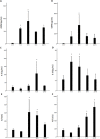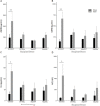Systemic inflammation and liver injury following hemorrhagic shock and peripheral tissue trauma involve functional TLR9 signaling on bone marrow-derived cells and parenchymal cells
- PMID: 20577143
- PMCID: PMC3000874
- DOI: 10.1097/SHK.0b013e3181eddcab
Systemic inflammation and liver injury following hemorrhagic shock and peripheral tissue trauma involve functional TLR9 signaling on bone marrow-derived cells and parenchymal cells
Abstract
Hemorrhagic shock due to trauma (HS/T) induces an inflammatory response that can contribute to end-organ injury. The pathways involved in the initiation and propagation of HS/T-induced inflammation are incompletely understood. Here, we hypothesized that the DNA sensor TLR9 would have a role in inflammatory signaling after HS/T. Using mice expressing a nonfunctional, mutant form of TLR9, we identified a role of TLR9 in driving the initial cytokine response and liver damage in a model of hemorrhagic shock and bilateral femur fracture. Circulating DNA levels were found to correlate with the degree of tissue damage. Experiments using chimeric mice show that TLR9 on both bone marrow-derived cells and parenchymal cells are important for the TLR9-mediated liver and tissue damage, as well as systemic inflammation after HS/T. These data suggest that release of DNA may be a driver of the inflammatory response to severe injury as well as a marker of the extent of tissue damage. One of the sensors of DNA in the setting of HS/T seems to be TLR9.
Figures






Similar articles
-
Eritoran attenuates tissue damage and inflammation in hemorrhagic shock/trauma.J Surg Res. 2013 Oct;184(2):e17-25. doi: 10.1016/j.jss.2013.03.023. Epub 2013 Mar 27. J Surg Res. 2013. PMID: 23777984 Free PMC article.
-
Systemic inflammation and end organ damage following trauma involves functional TLR4 signaling in both bone marrow-derived cells and parenchymal cells.J Leukoc Biol. 2008 Jan;83(1):80-8. doi: 10.1189/jlb.0407201. Epub 2007 Oct 9. J Leukoc Biol. 2008. PMID: 17925504
-
Targeting HSF1-TLR9 Axis: Celastrol as a Potential Therapeutic for Liver Injury in Traumatic Hemorrhagic Shock.Discov Med. 2025 Mar;37(194):503-514. doi: 10.24976/Discov.Med.202537194.42. Discov Med. 2025. PMID: 40116098
-
Flow Cytometric Analysis of Hematopoietic Populations in Rat Bone Marrow. Impact of Trauma and Hemorrhagic Shock.Cytometry A. 2019 Nov;95(11):1167-1177. doi: 10.1002/cyto.a.23903. Epub 2019 Oct 9. Cytometry A. 2019. PMID: 31595661 Free PMC article.
-
Toll-Like Receptor 4 on both Myeloid Cells and Dendritic Cells Is Required for Systemic Inflammation and Organ Damage after Hemorrhagic Shock with Tissue Trauma in Mice.Front Immunol. 2017 Nov 28;8:1672. doi: 10.3389/fimmu.2017.01672. eCollection 2017. Front Immunol. 2017. PMID: 29234326 Free PMC article.
Cited by
-
Delayed neutralization of interleukin 6 reduces organ injury, selectively suppresses inflammatory mediator, and partially normalizes immune dysfunction following trauma and hemorrhagic shock.Shock. 2014 Sep;42(3):218-27. doi: 10.1097/SHK.0000000000000211. Shock. 2014. PMID: 24978887 Free PMC article.
-
Effects of synthetic colloids on oxidative stress and inflammatory response in hemorrhagic shock: comparison of hydroxyethyl starch 130/0.4, hydroxyethyl starch 200/0.5, and succinylated gelatin.Crit Care. 2013 Jul 12;17(4):R141. doi: 10.1186/cc12820. Crit Care. 2013. PMID: 23849347 Free PMC article.
-
Eritoran attenuates tissue damage and inflammation in hemorrhagic shock/trauma.J Surg Res. 2013 Oct;184(2):e17-25. doi: 10.1016/j.jss.2013.03.023. Epub 2013 Mar 27. J Surg Res. 2013. PMID: 23777984 Free PMC article.
-
TLR9 is dispensable for intestinal ischemia/reperfusion-induced tissue damage.Am J Clin Exp Immunol. 2012;1(2):124-135. Am J Clin Exp Immunol. 2012. PMID: 23205322 Free PMC article.
-
Mouse Injury Model of Polytrauma and Shock.Methods Mol Biol. 2018;1717:1-15. doi: 10.1007/978-1-4939-7526-6_1. Methods Mol Biol. 2018. PMID: 29468579 Free PMC article. Review.
References
-
- Dewar D, Moore FA, Moore EE, Balogh Z. Postinjury multiple organ failure. Injury. 2009;40:912–918. - PubMed
-
- Lenz A, Franklin GA, Cheadle WG. Systemic inflammation after trauma. Injury. 2007;38:1336–1345. - PubMed
-
- Faist E, Baue AE, Dittmer H, Heberer G. Multiple organ failure in polytrauma patients. J Trauma. 1983;23:775–787. - PubMed
-
- Strecker W, Gebhard F, Rager J, Bruckner UB, Steinbach G, Kinzl L. Early biochemical characterization of soft-tissue trauma and fracture trauma. J Trauma. 1999;47:358–364. - PubMed
-
- Moore EE. Synergy of bone fractures, soft tissue disruption, and hemorrhagic shock in the genesis of postinjury immunochaos: the pathway to multiple organ failure. Crit Care Med. 1998;26:1305–1306. - PubMed
Publication types
MeSH terms
Substances
Grants and funding
LinkOut - more resources
Full Text Sources
Medical

